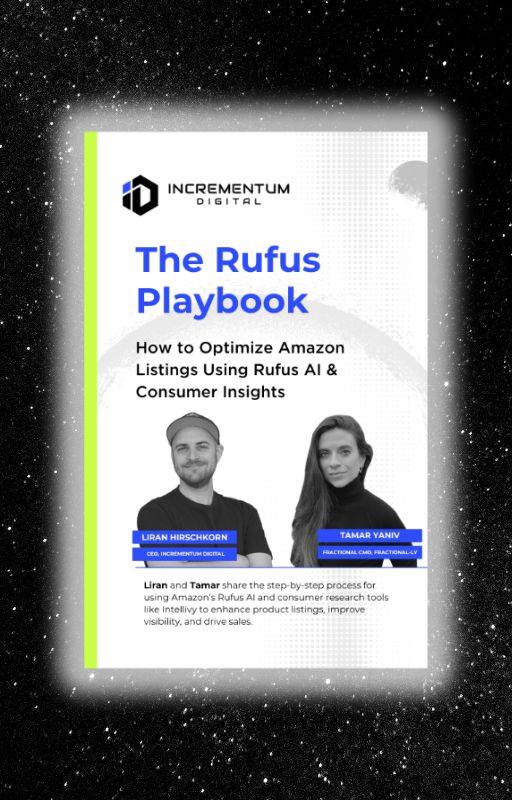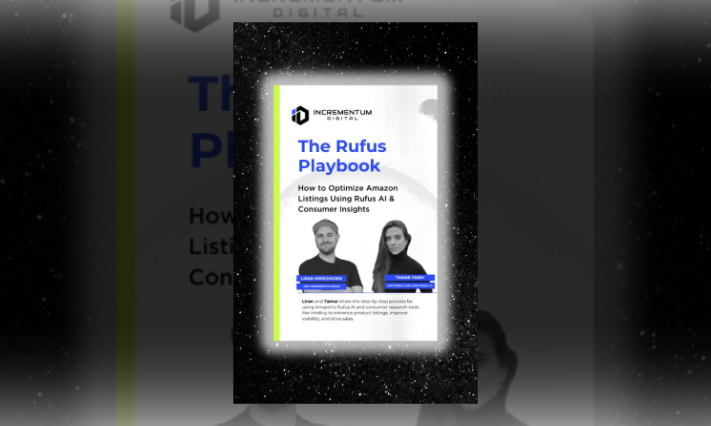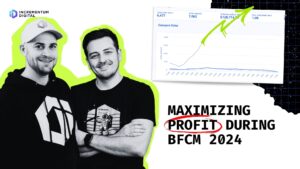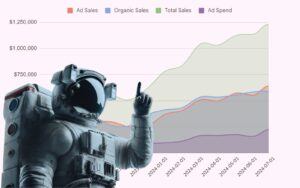Amazon Advertising
How We Helped a Premium Baby Apparel Brand Scale Sales by 71.5% Without Overspending on Ads

Amazon’s Big Spring Deals Sale offers a valuable testbed for refined Amazon advertising strategies. The insights we gained here can help shape the blueprint for major tentpoles like Prime Day. With CPCs climbing and competition tighter than ever, brands couldn’t afford to brute-force their way to the top. Winning required a smarter, more surgical approach.

Learn How to Make Listings That Convert in 2025!
Read our step-by-step guide on how to optimize your listings using Rufus AI insights. Sign up for our newsletter and get your copy for free!
Show me howIn this case study, we break down how our ads team helped a premium baby apparel brand increase daily sales by 71.5% while reducing TACoS by 48.53% year-over-year. No deep discounting. No wasted spend. Just a clear, performance-first strategy that turned Spring Sale momentum into long-term profitability.
The Challenge: Scaling Sales Without Sacrificing Profitability in a Highly Competitive Market
In 2025, the baby apparel category on Amazon is more crowded and price-sensitive than ever. Shoppers are flooded with options that look nearly identical, and many products are promoted with deep discounts and persuasive trust signals like high ratings or special badges. Even well-established brands face pressure to compete on price and visibility.
For our client, the challenge was convincing shoppers to choose their premium products at a higher price point. At the same time, they needed to maintain profitability while dealing with rising ad costs, inventory complexity across sizes and colors, and the risk of running out of stock mid-event. Scaling sales in a high-traffic moment like the Big Spring Deals Sale required a focused, controlled strategy that didn’t rely on discounting alone.
The Strategy: Profitable Growth Through Smart, Pre-Planned Advertising
To compete effectively in a saturated category without slashing margins, we needed a sharp, well-sequenced plan. Our focus was on maximizing return, not just driving volume. That meant every lever we pulled (budgets, keywords, audiences, timing) had to contribute to both scale and efficiency. Here’s how we made it work.
1. Budget Planning in Advance
We started by working with the client to finalize their ad budget well before the event began. This gave us a fixed financial framework to work within, which allowed for focused execution.
Rather than reacting to rising CPCs during the sale, we had already allocated spend toward the most impactful campaigns. Early budget planning also gave us time to align expectations with the client, forecast spending patterns, and identify areas where we might want to flex budget mid-sale.
That upfront clarity created a smoother workflow during the event, with no last-minute approvals slowing us down and no wasted spend going to underperforming initiatives.
2. Ranking Optimization Ahead of the Event
With the budget set, we turned to keyword rankings. We identified the client’s top-performing SKUs and focused efforts on improving their visibility in search results in the weeks leading up to the event. This gave those products time to climb in organic ranking, which meant more visibility at no additional cost.
One of the client’s top products had already earned a Best Seller badge in a key subcategory. We used this as a trust signal and performance anchor, allocating more budget and keyword coverage to this product to reinforce its momentum. During the sale, it earned a second Best Seller badge in a related category—a clear validation of the ranking and conversion groundwork we laid ahead of time.
Ranking higher ahead of the event also drives a flywheel effect: as products gain clicks and conversions, they continue to improve in relevance and visibility.
The client already had strong reviews and solid conversion rates, which gave us a strong foundation to build on. By amplifying these signals through sponsored and organic placement, we increased shopper trust and reinforced relevance to Amazon’s algorithm. This groundwork meant the client entered the event with momentum, and that momentum reduced the need for aggressive bidding during the event itself. It also positioned the brand as a top contender in the category right when traffic was at its peak.
By front-loading ranking optimization, we reduced the client’s reliance on aggressive paid search bids during the event. That allowed us to focus our budget on strategic placements instead of spending heavily to appear in competitive top-of-search slots. It also helped build buyer trust—products that rank higher are perceived as more credible, which increases conversion rates. Entering the event with momentum was crucial to making every ad dollar go further.
If you’re curious to know how Amazon determines organic rankings and how to improve them, find out here.
3. Strategic Category Expansion
We didn’t just target baby booties. Knowing that parents shop across related categories, we expanded our targeting to include adjacent niches like baby socks, mittens, and apparel accessories. This move allowed us to tap into broader search behavior and reach new audiences who weren’t searching for the exact product but were still in the mindset to buy. On Amazon, discovery often starts with one keyword but quickly pivots based on suggestions, reviews, and visual interest. Expanding category coverage helped us insert the brand into those peripheral purchase paths.
This strategy works particularly well for baby products because shoppers often bundle items: booties with socks, mittens with hats. Appearing in more relevant categories gave the brand multiple entry points into the shopper journey, leading to cross-selling opportunities and increased cart sizes. Beyond driving immediate sales, this approach helped us collect data on category crossover behavior, giving the client new insights into where they could scale next. What started as an awareness play turned into a high-performing tactic that revealed untapped potential for future growth.
The primary goal was awareness, but the expanded reach translated into incremental sales, especially in categories with less competition or where the client had room to stand out. It also helped us better understand which adjacent categories had potential for future scaling, turning a short-term test into a long-term growth lever.
4. Retargeting with Display Ads
We used Sponsored Display campaigns to re-engage shoppers who had viewed the client’s products but hadn’t purchased. While video wasn’t included in these retargeting efforts, Display ads helped us stay present across the buyer journey and reconnect with high-intent audiences.
What made this tactic especially effective was its relevance to the baby apparel buying cycle. Parents often shop in phases as their child grows. By retargeting based on past engagement, we positioned the brand to capture future purchases (like larger sizes or design variants) without starting from scratch with cold audiences. This lifecycle-aware retargeting helped drive conversions during the event and supported repeat purchases over time.
5. Pausing Dayparting for Full Visibility
Dayparting (restricting ads to run only during selected hours) can be a smart cost-saving tactic during normal periods. However, during a high-volume event like the Big Spring Deals Sale, that same tactic risks cutting off exposure right when potential buyers are most active. Shopper behavior during sales events is unpredictable. People browse during breaks at work, late at night, or early in the morning when deals are top of mind.
By disabling dayparting, we gave the campaigns full runway to capture traffic whenever it came. This ensured we didn’t miss spontaneous shopping moments or overnight spikes in interest. It also helped stabilize campaign delivery, smoothing out pacing and giving us more consistent data to work with across the entire 24-hour cycle. For time-sensitive promotions, staying live around the clock is critical, and in this case, it paid off.
6. Real-Time Budget Reallocation
Our team monitored the client’s campaigns closely throughout the event, analyzing which SKUs were gaining traction and which weren’t converting efficiently. Rather than waiting for a post-event review, we made adjustments in real time by scaling spend on high-performing campaigns to capitalize on momentum and pulling back on those that weren’t delivering.
This fluid, data-driven approach allowed us to get more out of the budget without spending more overall. By reallocating funds dynamically, we kept performance tight and avoided wasted impressions. It also gave us the agility to double down on breakout products that were exceeding expectations. Real-time budget management helped us keep TACoS low while driving volume, making it one of the most important levers in hitting both our sales and efficiency targets.
We sold 71.5% more units during the Spring event compared to an average day in March. TACoS dropped by 48.53% year-over-year, driven by smarter spend allocation and a focus on more profitable sales.
Key Takeaways for E-Commerce Leaders
Sales events offer major upside, but only for brands that prepare. The strongest results came from clients who planned ahead, invested in their high-performing products, and stayed agile when the data called for adjustments. Tactics like ranking optimization, category expansion, and real-time budget scaling made a measurable difference.
The lesson is simple: Growth is good, but growth with control is better. Success during high-traffic events like the Big Spring Deals Sale doesn’t require a bigger budget. It requires a smarter one.
LET’S DISCOVER WHAT’S POSSIBLE FOR YOUR BRAND
We’re here to listen and uncover opportunities tailored to your unique goals.
Fill out the form to get started, and you’ll walk away with real insights and actionable recommendations—whether we work together or not.
- HANDS-ON LEADERSHIP
- AWARD-WINNING PARTNERSHIPS
- CUSTOM-BUILT SOLUTIONS




